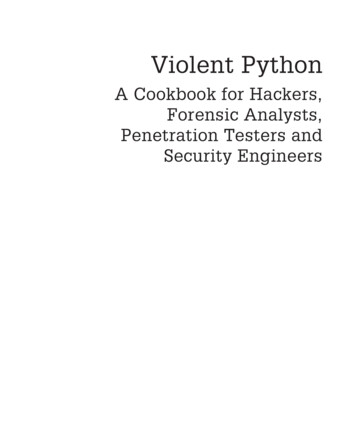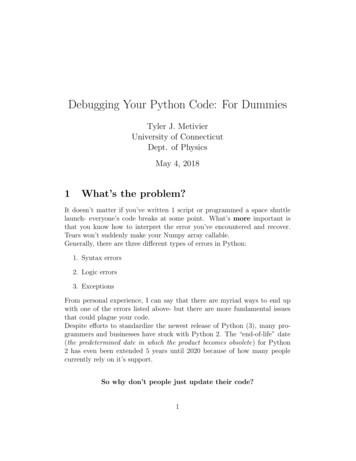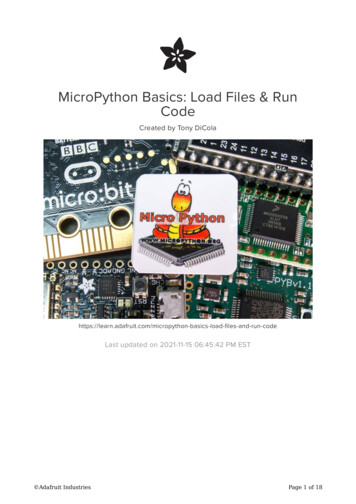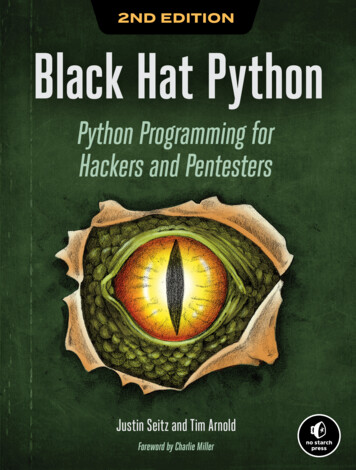
Transcription
Violent PythonA Cookbook for Hackers,Forensic Analysts,Penetration Testers andSecurity Engineers
Violent PythonA Cookbook for Hackers,Forensic Analysts,Penetration Testers andSecurity EngineersTJ. O’Connor!-34%2 !- s "/34/. s (%) %,"%2' s ,/. /.%7 9/2 s /8&/2 s 0!2)3 s 3!. )%'/3!. &2!.#)3#/ s 3).'!0/2% s 39 .%9 s 4/ 9/3YNGRESS IS AN )MPRINT OF %LSEVIER
Acquiring Editor:Development Editor:Project Manager:Designer:Chris KatsaropoulosMeagan WhitePriya KumaraguruparanRussell PurdySyngress is an imprint of Elsevier225 Wyman Street, Waltham, MA 02451, USACopyright 2013 Elsevier, Inc. All rights reserved.No part of this publication may be reproduced or transmitted in any form or by any means,electronic or mechanical, including photocopying, recording, or any information storage andretrieval system, without permission in writing from the publisher. Details on how to seekpermission, further information about the Publisher’s permissions policies and our arrangements with organizations such as the Copyright Clearance Center and the Copyright LicensingAgency, can be found at our website: www.elsevier.com/permissions.This book and the individual contributions contained in it are protected under copyright by thePublisher (other than as may be noted herein).NoticesKnowledge and best practice in this field are constantly changing. As new research and experience broaden our understanding, changes in research methods or professional practices, maybecome necessary. Practitioners and researchers must always rely on their own experience andknowledge in evaluating and using any information or methods described herein. In using suchinformation or methods they should be mindful of their own safety and the safety of others,including parties for whom they have a professional responsibility.To the fullest extent of the law, neither the Publisher nor the authors, contributors, or editors,assume any liability for any injury and/or damage to persons or property as a matter of productsliability, negligence or otherwise, or from any use or operation of any methods, products,instructions, or ideas contained in the material herein.Library of Congress Cataloging-in-Publication DataApplication submittedBritish Library Cataloguing-in-Publication DataA catalogue record for this book is available from the British Library.ISBN: 978-1-59749-957-6Printed in the United States of America13 14 15 10 9 8 7 6 5 4 3 2 1For information on all Syngress publications visit our website at www.syngress.com
Trademarks%LSEVIER )NC THE AUTHOR S AND ANY PERSON OR lRM INVOLVED IN THE WRITINGEDITING OR PRODUCTION COLLECTIVELY h-AKERSv OF THIS BOOK hTHE 7ORKv DONOT GUARANTEE OR WARRANT THE RESULTS TO BE OBTAINED FROM THE 7ORK 4HERE IS NO GUARANTEE OF ANY KIND EXPRESSED OR IMPLIED REGARDING THE 7ORK ORITS CONTENTS 4HE 7ORK IS SOLD !3 )3 AND 7)4(/54 7!22!.49 9OU MAY HAVEOTHER LEGAL RIGHTS WHICH VARY FROM STATE TO STATE )N NO EVENT WILL -AKERS BE LIABLE TO YOU FOR DAMAGES INCLUDING ANY LOSS OFPROlTS LOST SAVINGS OR OTHER INCIDENTAL OR CONSEQUENTIAL DAMAGES ARISING OUTFROM THE 7ORK OR ITS CONTENTS "ECAUSE SOME STATES DO NOT ALLOW THE EXCLUSIONOR LIMITATION OF LIABILITY FOR CONSEQUENTIAL OR INCIDENTAL DAMAGES THE ABOVELIMITATION MAY NOT APPLY TO YOU 9OU SHOULD ALWAYS USE REASONABLE CARE INCLUDING BACKUP AND OTHER APPROPRIATE PRECAUTIONS WHEN WORKING WITH COMPUTERS NETWORKS DATA AND lLES 3YNGRESS -EDIA 3YNGRESS h#AREER !DVANCEMENT 4HROUGH 3KILL %NHANCEMENT v h!SK THE !UTHOR 50 !4% v AND h(ACK 0ROOlNG v ARE REGISTEREDTRADEMARKS OF %LSEVIER )NC h3YNGRESS 4HE ElNITION OF A 3ERIOUS 3ECURITY,IBRARYv4- h-ISSION #RITICAL4- v AND h4HE /NLY 7AY TO 3TOP A (ACKER IS TO4HINK ,IKE /NE4-v ARE TRADEMARKS OF %LSEVIER )NC "RANDS AND PRODUCT NAMESMENTIONED IN THIS BOOK ARE TRADEMARKS OR SERVICE MARKS OF THEIR RESPECTIVECOMPANIES v
DedicationFor my monkey and my ninja princess: anything ispossible if you try hard enough.ix
Lead Author – TJ O’Connor4* / #ONNOR IS A EPARTMENT OF EFENSE EXPERT ON INFORMATION SECURITY ANDA 53 !RMY PARATROOPER 7HILE ASSIGNED AS AN ASSISTANT PROFESSOR AT THE 53-ILITARY !CADEMY 4* TAUGHT UNDERGRADUATE COURSES ON FORENSICS EXPLOITATION AND INFORMATION ASSURANCE (E TWICE CO COACHED THE WINNING TEAM ATTHE .ATIONAL 3ECURITY !GENCY S ANNUAL #YBER EFENSE %XERCISE AND WON THE.ATIONAL EFENSE 5NIVERSITY S lRST ANNUAL #YBER #HALLENGE (E HAS SERVED ONMULTIPLE RED TEAMS INCLUDING TWICE ON THE .ORTHEAST 2EGIONAL 4EAM FOR THE.ATIONAL #OLLEGIATE #YBER EFENSE #OMPETITION 4* HOLDS A -ASTER OF 3CIENCE DEGREE IN #OMPUTER 3CIENCE FROM .ORTH #AROLINA3TATE A -ASTER OF 3CIENCE DEGREE IN )NFORMATION 3ECURITY %NGINEERING FROMTHE 3!.3 4ECHNICAL )NSTITUTE AND A "ACHELOR OF 3CIENCE DEGREE IN #OMPUTER3CIENCE FROM THE 53 -ILITARY !CADEMY (E HAS PUBLISHED TECHNICAL RESEARCH AT53%.)8 WORKSHOPS !#- CONFERENCES SECURITY CONFERENCES THE 3!.3 2EADING 2OOM THE )NTERNET 3TORM #ENTER THE Army Magazine AND THE Armed ForcesJournal (E HOLDS EXPERT CYBER SECURITY CREDENTIALS INCLUDING THE PRESTIGIOUS')!# 3ECURITY %XPERT '3% AND /FFENSIVE 3ECURITY #ERTIlED %XPERT /3#% 4* IS A MEMBER OF THE ELITE 3!.3 2ED AND "LUE 4EAM #YBER 'UARDIANS xvii
Contributing Author Bio – Rob Frost2OBERT &ROST GRADUATED FROM THE 5NITED 3TATES -ILITARY !CADEMY IN COMMISSIONING INTO THE !RMY 3IGNAL #ORPS (E HOLDS A "ACHELOR OF 3CIENCEDEGREE IN #OMPUTER 3CIENCE WITH HONORS WITH HIS THESIS WORK FOCUSING ONOPEN SOURCE INFORMATION GATHERING 2OB WAS INDIVIDUALLY RECOGNIZED AS ONE OFTHE TOP TWO MEMBERS OF THE NATIONAL CHAMPIONSHIP TEAM FOR THE #YBER EFENSE %XERCISE DUE TO HIS ABILITY TO CIRCUMVENT RULES 2OB HAS PARTICIPATED INAND WON SEVERAL CYBER SECURITY COMPETITIONS xix
Technical Editor Bio – Mark Baggett-ARK "AGGETT IS A #ERTIlED 3!.3 )NSTRUCTOR AND TEACHES SEVERAL COURSES IN THE3!.3 PENETRATION TESTING CURRICULUM -ARK IS THE PRIMARY CONSULTANT ANDFOUNDER OF )N EPTH EFENSE )NC WHICH PROVIDES INCIDENT RESPONSE ANDPENETRATION TESTING SERVICES 4ODAY IN HIS ROLE AS THE TECHNICAL ADVISOR TO THE EPARTMENT OF EFENSE FOR 3!.3 -ARK IS FOCUSED ON THE PRACTICAL APPLICATIONOF 3!.3 RESOURCES IN THE DEVELOPMENT OF MILITARY CAPABILITIES -ARK HAS HELD A VARIETY OF POSITIONS IN INFORMATION SECURITY FOR LARGE INTERNATIONAL AND &ORTUNE COMPANIES (E HAS BEEN A SOFTWARE DEVELOPER A NETWORK AND SYSTEMS ENGINEER A SECURITY MANAGER AND A #)3/ !S A #)3/ -ARKWAS RESPONSIBLE FOR POLICY COMPLIANCE INCIDENT RESPONSE AND ALL OTHER ASPECTSOF INFORMATION SECURITY OPERATIONS -ARK KNOWS lRSTHAND THE CHALLENGES THATINFORMATION SECURITY PROFESSIONALS FACE TODAY IN SELLING IMPLEMENTING ANDSUPPORTING INFORMATION SECURITY -ARK IS AN ACTIVE MEMBER OF THE INFORMATIONSECURITY COMMUNITY AND THE FOUNDING PRESIDENT OF THE 'REATER !UGUSTA )33! (E HOLDS SEVERAL CERTIlCATIONS INCLUDING 3!.3 PRESTIGIOUS '3% -ARK BLOGSABOUT VARIOUS SECURITY TOPICS AT HTTP WWW PAULDOTCOM COM xxi
Introduction0YTHON IS A HACKER S LANGUAGE 7ITH ITS DECREASED COMPLEXITY INCREASED EFlCIENCY LIMITLESS THIRD PARTY LIBRARIES AND LOW BAR TO ENTRY 0YTHON PROVIDES ANEXCELLENT DEVELOPMENT PLATFORM TO BUILD YOUR OWN OFFENSIVE TOOLS )F YOU ARERUNNING -AC /3 8 OR ,INUX ODDS ARE IT IS ALREADY INSTALLED ON YOUR SYSTEM 7HILE A WEALTH OF OFFENSIVE TOOLS ALREADY EXIST LEARNING 0YTHON CAN HELP YOUWITH THE DIFlCULT CASES WHERE THOSE TOOLS FAIL TARGET AUDIENCE%VERYONE LEARNS DIFFERENTLY (OWEVER WHETHER YOU ARE A BEGINNER WHO WANTSTO LEARN HOW TO WRITE 0YTHON OR AN ADVANCED PROGRAMMER WHO WANTS TO LEARNHOW TO APPLY YOUR SKILLS IN PENETRATION TESTING THIS BOOK IS FOR YOU ORGANIZATION OF THE BOOK)N WRITING THIS BOOK WE REALLY SET OUT TO WRITE AN EVIL COOKBOOK OF EXAMPLESFOR THE DARKER SIDE OF 0YTHON 4HE FOLLOWING PAGES PROVIDE 0YTHON RECIPESFOR PENETRATION TESTING WEB ANALYSIS NETWORK ANALYSIS FORENSIC ANALYSIS ANDEXPLOITING WIRELESS DEVICES (OPEFULLY THE EXAMPLES WILL INSPIRE THE READER TOCREATE HIS OR HER OWN 0YTHON SCRIPTS Chapter 1: Introduction)F YOU HAVE NOT PROGRAMMED IN 0YTHON BEFORE #HAPTER PROVIDES BACKGROUNDINFORMATION ABOUT THE LANGUAGE VARIABLES DATA TYPES FUNCTIONS ITERATIONSELECTION AND WORKING WITH MODULES AND METHODICALLY WALKS THROUGH WRITING A FEW SIMPLE PROGRAMS &EEL FREE TO SKIP IT IF YOU ARE ALREADY COMFORTABLEWITH THE 0YTHON PROGRAMMING LANGUAGE !FTER THE lRST CHAPTER THE FOLLOWINGSIX CHAPTERS ARE FAIRLY INDEPENDENT FROM ONE ANOTHER FEEL FREE TO READ THEM INWHICHEVER ORDER YOU PLEASE ACCORDING TO WHAT STRIKES YOUR CURIOSITY xxiii
xxivIntroductionChapter 2: Penetration Testing with Python#HAPTER INTRODUCES THE IDEA OF USING THE 0YTHON PROGRAMMING LANGUAGETO SCRIPT ATTACKS FOR PENETRATION TESTING 4HE EXAMPLES IN THE CHAPTER INCLUDEBUILDING A PORT SCANNER CONSTRUCTING AN 33( BOTNET MASS COMPROMISING VIA&40 REPLICATING #ONlCKER AND WRITING AN EXPLOIT Chapter 3: Forensic Investigations with Python#HAPTER UTILIZES 0YTHON FOR DIGITAL FORENSIC INVESTIGATIONS 4HIS CHAPTER PROVIDES EXAMPLES FOR GEO LOCATING INDIVIDUALS RECOVERING DELETED ITEMS EXTRACTING ARTIFACTS FROM THE 7INDOWS REGISTRY EXAMINING METADATA IN DOCUMENTS ANDIMAGES AND INVESTIGATING APPLICATION AND MOBILE DEVICE ARTIFACTS Chapter 4: Network Traffic Analysis with Python#HAPTER USES 0YTHON TO ANALYZE NETWORK TRAFlC 4HE SCRIPTS IN THIS CHAPTERGEO LOCATE )0 ADDRESSES FROM PACKET CAPTURES INVESTIGATE POPULAR O3 TOOLKITS DISCOVER DECOY SCANS ANALYZE BOTNET TRAFlC AND FOIL INTRUSION DETECTIONSYSTEMS Chapter 5: Wireless Mayhem with Python#HAPTER CREATES MAYHEM FOR WIRELESS AND "LUETOOTH DEVICES 4HE EXAMPLES INTHIS CHAPTER SHOW HOW TO SNIFF AND PARSE WIRELESS TRAFlC BUILD A WIRELESS KEYLOGGER IDENTIFY HIDDEN WIRELESS NETWORKS REMOTELY COMMAND 5!6S IDENTIFYMALICIOUS WIRELESS TOOLKITS IN USE STALK "LUETOOTH RADIOS AND EXPLOIT "LUETOOTH VULNERABILITIES Chapter 6: Web Recon With Python#HAPTER EXAMINES USING 0YTHON TO SCRAPE THE WEB FOR INFORMATION 4HEEXAMPLES IN THIS CHAPTER INCLUDE ANONYMOUSLY BROWSING THE WEB VIA 0YTHONWORKING WITH DEVELOPER !0)S SCRAPING POPULAR SOCIAL MEDIA SITES AND CREATINGA SPEAR PHISHING EMAIL Chapter 7: Antivirus Evasion with Python)N THE &INAL CHAPTER #HAPTER WE BUILD A PIECE OF MALWARE THAT EVADES ANTIVIRUS SYSTEMS !DDITIONALLY WE BUILD A SCRIPT FOR UPLOADING OUR MALWARE AGAINSTAN ONLINE ANTIVIRUS SCANNER
IntroductionCOMPANION WEB SITE4HE COMPANION WEBSITE CONTAINS ALL THE CODE INCLUDED IN THIS BOOK 6ISITHTTP WWW ELSEVIERDIRECT COM COMPANION JSP )3". TO DOWNLOAD THE EXAMPLES ARTIFACTS AND NETWORK CAPTURES TO DOWNLOAD THEM AS YOUWORK THROUGH THE BOOK xxv
CHAP TER 1IntroductionINFORMATION IN THIS CHAPTER: Setting up a Development Environment for PythonIntroduction to the Python Programming LanguageAn Explanation of Variables, Data types, Strings, Lists, Dictionaries,FunctionsWork with Networking, Iteration, Selection, Exception Handling andModulesWrite Your First Python Program, a Dictionary Password CrackerWrite Your Second Python Program, a Zipfile Brute-Force CrackerTo me, the extraordinary aspect of martial arts lies in its simplicity.The easy way is also the right way, and martial arts is nothing at allspecial; the closer to the true way of martial arts, the less wastage ofexpression there is.– Master Bruce Lee, Founder, Jeet Kune DoINTRODUCTION: A PENETRATION TEST WITHPYTHONRecently, a friend of mine penetration tested a Fortune 500 company’s computersecurity system. While the company had established and maintained anexcellent security scheme, he eventually found a vulnerability in an unpatchedserver. Within a few minutes, he used open source tools to compromise thesystem and gained administrative access to it. He then scanned the remainingservers as well as the clients and did not discover any additional vulnerabilities.At this point his assessment ended and the true penetration test began.Violent Python. -6Copyright 2013 Elsevier Inc. All rights reserved.CONTENTSIntroduction:A Penetration Testwith Python .1Setting Up YourDevelopmentEnvironment.2Installing Third PartyLibraries .3Interpreted PythonVersus InteractivePython.5The PythonLanguage.6Variables .7Strings.7Lists .8Dictionaries .9Networking .9Selection .10Exception Handling .10Functions .12Iteration .14File I/O .16Sys Module .17OS Module .18Your First PythonPrograms .20Setting the Stage forYour First PythonProgram:The Cuckoo’s Egg .201
2CHAPTER 1:IntroductionYour First Program, aUNIX PasswordCracker .21Setting the Stage forYour Second Program:Using Evil for Good.24Your Second Program,a Zip-File PasswordCracker .24Chapter Wrap-Up .29References .29Opening the text editor of his choice, my friend wrote a Python script to testthe credentials found on the vulnerable server against the remainder of themachines on the network. Literally, minutes later, he gained administrativeaccess to over one thousand machines on the network. However, in doing so,he was subsequently presented with an unmanageable problem. He knewthe system administrators would notice his attack and deny him access so hequickly used some triage with the exploited machines in order to find outwhere to install a persistent backdoor.After examining his pentest engagement document, my friend realizedthat his client placed a high level of importance on securing the domaincontroller. Knowing the administrator logged onto the domain controllerwith a completely separate administrator account, my friend wrote a smallscript to check a thousand machines for logged on users. A little while later,my friend was notified when the domain administrator logged onto one ofthe machines. His triage essentially complete, my friend now knew where tocontinue his assault.My friend’s ability to quickly react and think creatively under pressure madehim a penetration tester. He forged his own tools out of short scripts inorder to successfully compromise the Fortune 500 Company. A small Pythonscript granted him access to over one thousand workstations. Another smallscript allowed him to triage the one thousand workstations before an adeptadministrator disconnected his access. Forging your own weapons to solveyour own problems makes you a true penetration tester.Let us begin our journey of learning how to build our own tools, by installingour development environment.SETTING UP YOUR DEVELOPMENT ENVIRONMENTThe Python download site (http://www.python.org/download/) provides arepository of Python installers for Windows, Mac OS X, and Linux OperatingSystems. If you are running Mac OS X or Linux, odds are the Pythoninterpreter is already installed on your system. Downloading an installerprovides a programmer with the Python interpreter, the standard library, andseveral built-in modules. The Python standard library and built-in modulesprovide an extensive range of capabilities, including built-in data types,exception handling, numeric, and math modules, file-handling capabilities,cryptographic services, interoperability with the operating system, Internetdata handling, and interaction with IP protocols, among many other usefulmodules. However, a programmer can easily install any third-party packages.A comprehensive list of third-party packages is available at http://pypi.python.org/pypi/.
Setting Up Your Development EnvironmentInstalling Third Party LibrariesIn Chapter two, we will utilize the python-nmap package to handle parsing ofnmap results. The following example depicts how to download and install thepython-nmap package (or any package, really). Once we have saved the packageto a local file, we uncompress the contents and change into the uncompresseddirectory. From that working directory, we issue the command python setup.pyinstall, which installs the python-nmap package. Installing most third-partypackages will follow the same steps of downloading, uncompressing, and thenissuing the command python setup.py install.programmer: # wget ap-0.2.4.tar.gz-On map.tar.gz--2012-04-24 p/python-nmap-0.2.4.tar.gzResolving xael.org. 194.36.166.10Connecting to xael.org 194.36.166.10 :80. connected.HTTP request sent, awaiting response. 200 OKLength: 29620 (29K) [application/x-gzip]Saving to: 'nmap.tar.gz'100%[ ] 29,620 60.8K/s in 0.5s2012-04-24 15:51:52 (60.8 KB/s) - 'nmap.tar.gz' saved [29620/29620]programmer: # tar -xzf nmap.tar.gzprogrammer: # cd python-nmap-0.2.4/programmer: /python-nmap-0.2.4# python setup.py installrunning installrunning buildrunning build pycreating buildcreating build/lib.linux-x86 64-2.6creating build/lib.linux-x86 64-2.6/nmapcopying nmap/ init .py - build/lib.linux-x86 64-2.6/nmapcopying nmap/example.py - build/lib.linux-x86 64-2.6/nmapcopying nmap/nmap.py - build/lib.linux-x86 64-2.6/nmaprunning install libcreating /usr/local/lib/python2.6/dist-packages/nmapcopying build/lib.linux-x86 64-2.6/nmap/ init .py - /usr/local/lib/python2.6/dist-packages/nmapcopying build/lib.linux-x86 64-2.6/nmap/example.py - /usr/local/lib/python2.6/dist-packages/nmap3
4CHAPTER 1:Introductioncopying build/lib.linux-x86 64-2.6/nmap/nmap.py - mpiling /usr/local/lib/python2.6/dist-packages/nmap/ init .pyto init .pycbyte-compiling e.pyto example.pycbyte-compiling y tonmap.pycrunning install egg infoWriting /usr/local/lib/python2.6/dist-packages/python nmap-0.2.4.egginfoTo make installing Python packages even easier, Python setuptools providesa Python module called easy install. Running the easy installer module followed by the name of the package to install will search through Python repositories to find the package, download it if found, and install it automatically.programmer: # easy install python-nmapSearching for hon-nmap/Best match: python-nmap on-nmap/python-nmap0.2.4.tar.gzProcessing python-nmap-0.2.4.tar.gzRunning python-nmap-0.2.4/setup.py -q bdist egg --dist-dir -tmp-EOPENszip safe flag not set; analyzing archive contents.Adding python-nmap 0.2.4 to easy-install.pth fileInstalled /usr/local/lib/python2.6/dist-packages/python nmap-0.2.4py2.6.eggProcessing dependencies for python-nmapFinished processing dependencies for python-nmapTo rapidly establish a development environment, we suggest you downloada copy of the latest BackTrack Linux Penetration Testing Distribution fromhttp://www.backtrack-linux.org/downloads/. The distribution provides awealth of tools for penetration testing, along with forensic, web, networkanalysis, and wireless attacks. Several of the following examples will rely ontools or libraries that are already a part of the BackTrack distribution. Whenan example in the book requires a third-party package outside of the standardlibrary and built-in modules, the text will provide a download site.
Setting Up Your Development EnvironmentWhen setting up a developmental environment, it may prove useful to downloadall of these third-party modules before beginning. On Backtrack, you can installthe additional required libraries with easy install by issuing the following command. This will install most of the required libraries for the examples under Linux.programmer: # easy install pyPdf python-nmap pygeoip mechanizeBeautifulSoup4Chapter five requires some specific Bluetooth libraries that are not availablefrom easy install. You can use the aptitude package manager to download andinstall these librariers.attacker# apt-get install python-bluez bluetooth python-obexftpReading package lists. DoneBuilding dependency treeReading state information. Done .SNIPPED. Unpacking bluetooth (from ./bluetooth 4.60-0ubuntu8 all.deb)Selecting previously deselected package python-bluez.Unpacking python-bluez (from ./python-bluez 0.18-1 amd64.deb)Setting up bluetooth (4.60-0ubuntu8) .Setting up python-bluez (0.18-1) .Processing triggers for python-central .Additionally, a few examples in Chapter five and seven require a Windowsinstallation of Python. For the latest Python Windows Installer, visit http://www.python.org/getit/.In recent years, the source code for Python has forked into two stablebranches-2.x, and 3.x. The original author of Python, Guido van Rossum,sought to clean up the code to make the language more consistent. This actionintentionally broke backward compatibility with the Python 2.x release. Forexample, the author replaced the print statement in Python 2.x with a print()function that required arguments as parameters. The examples contained in thefollowing chapter are meant for the 2.x branch. At the time of this book’s publication, BackTrack 5 R2 offered Python 2.6.5 as the stable version of Python.programmer# python -VPython 2.6.5Interpreted Python Versus Interactive PythonSimilar to other scripting languages, Python is an interpreted language. Atruntime an interpreter processes the code and executes it. To demonstrate theuse of the Python interpreter, we write print “Hello World” to a file with a .py5
6CHAPTER 1:Introductionextension. To interpreter this new script, we invoke the Python interpreterfollowed by the name of the newly created script.programmer# echo print \"Hello World\" hello.pyprogrammer# python hello.pyHello WorldAdditionally, Python provides interactive capability. A programmer can invokethe Python interpreter and interact with the interpreter directly. To start theinterpreter, the programmer executes python with no arguments. Next, the interpreter presents the programmer with a prompt, indicating it can accept acommand. Here, the programmer again types print “Hello World.” Upon hittingreturn, the Python interactive interpreter immediately executes the statement.programmer# pythonPython 2.6.5 (r265:79063, Apr 16 2010, 13:57:41)[GCC 4.4.3] on linux2 print "Hello World"Hello WorldTo initially understand some of the semantics behind the language, this chapteroccasionally utilizes the interactive capability of the Python interpreter. Youcan spot the interactive interpreter in usage by looking for the prompt inthe examples.As we explain the Python examples in the following chapters, we will build ourscripts out of several functional blocks of code known as methods or functions.As we finalize each script, we will show how to reassemble these methods andinvoke them from the main() method. Trying to run a script that just contains theisolated function definitions without a call to invoke them will prove unhelpful.For the most part, you can spot the completed scripts because they will have amain() function defined. Before we start writing our first program though, wewill illustrate several of the key components of the Python standard library.THE PYTHON LANGUAGEIn the following pages, we will tackle the idea of variables, data types, strings,complex data structures, networking, selection, iteration, file handling,exception handling, and interoperability with the operating system. To illustratethis, we will build a simple vulnerability scanner that connects to a TCP socket,reads the banner from a service, and compares that banner against known vulnerable service versions. As an experienced programmer, you may find some
The Python Languageof the initial code examples very ugly in design. In fact, hopefully you do.As we continue to develop our script in this section, the script will hopefullygrow into an elegant design you can appreciate. Let’s begin by starting with thebedrock of any programming language—variables.VariablesIn Python, a variable points to data stored in a memory location. This memorylocation can store different values such as integers, real numbers, Booleans,strings, or more complex data such as lists or dictionaries. In the followingcode, we define a variable port that stores an integer and banner that stores astring. To combine the two variables together into one string, we must explicitlycast the port as a string using the str() function. port 21 banner "FreeFloat FTP Server" print "[ ] Checking for " banner " on port " str(port)[ ] Checking for FreeFloat FTP Server on port 21Python reserves memory space for variables when the programmer declaresthem. The programmer does not have to explicitly declare the type of variable;rather, the Python interpreter decides the type of the variable and how muchspace in the memory to reserve. Considering the following example, wedeclare a string, an integer, a list, and a Boolean, and the interpreter correctlyautomatically types each variable. banner "FreeFloat FTP Server" # A string type(banner) type 'str' port 21# An integer type(port) type 'int' portList [21,22,80,110]# A list type(portList) type 'list' portOpen True# A boolean type(portOpen) type 'bool' StringsThe Python string module provides a very robust series of methods for strings.Read the Python documentation at http://docs.python.org/library/string.htmlfor the entire list of available methods. Let’s examine a few useful methods.7
8CHAPTER 1:IntroductionConsider the use of the following methods: upper(), lower(), replace(), andfind(). Upper() converts a string to its uppercase variant. Lower() converts astring to its lowercase variant. Replace(old,new) replaces the old occurrence ofthe substring old with the substring new. Find() reports the offset where thefirst occurrence of the substring occurs. banner "FreeFloat FTP Server" print banner.upper()FREEFLOAT FTP SERVER print banner.lower()freefloat ftp server print banner.replace('FreeFloat','Ability')Ability FTP Server print banner.find('FTP')10ListsThe list data structure in Python provides an excellent method for storingarrays of objects in Python. A programmer can construct lists of any data type.Furthermore, built-in methods exist for performing actions such as appending,inserting, removing, popping, indexing, counting, sorting, and reversing lists.Consider the following example: a programmer can construct a list by appending items using the append() method, print the items, and then sort thembefore printing again. The programmer can find the index of a particular item(the integer 80 in this example). Furthermore, specific items can be removed(the integer 443 in this example). portList [] portList.append(21) portList.append(80) portList.append(443) portList.append(25) print portList[21, 80, 443, 25] portList.sort() print portList[21, 25, 80, 443] pos portList.index(80) print "[ ] There are " str(pos) " ports to scan before 80."[ ] There are 2 ports to scan before 80.
The Python Language portList.remove(443) print portList[21, 25, 80] cnt len(portList) print "[ ] Scanning " str(cnt) " Total Ports."[ ] Scanning 3 Total Ports.DictionariesThe Python dictionary data structure provides a hash table that can storeany number of Python objects. The dictionary consists of pairs of items thatcontain a key and value. Let’s continue with our example of a vulnerabilityscanner to illustrate a Python dictionary. When scanning specific TCP ports, itmay prove useful to have a dictionary that contains the common service namesfor each port. Creating a dictionary, we can lookup a key like ftp and return theassociated value 21 for that port.When constructing a dictionary, each key is separated from its value by a colon,and we separate items by commas. Notice that the method .keys() will returna list of all keys in the dictionary and that the method .items() will return anentire list of items in the dictionary. Next, we verify that the dictionary containsa specific key (ftp). Referencing this key returns the value 21. services {'ftp':21,'ssh':22,'smtp':25,'http':80} services.keys()['ftp', 'smtp', 'ssh', 'http'] services.items()[('ftp', 21), ('smtp', 25), ('ssh', 22), ('http', 80)] services.has key('ftp')True services['ftp']21 print "[ ] Found vuln with FTP on port " str(services['ftp'])[ ] Found vuln with FTP on port 21NetworkingThe socket module provides a library for making network connections usingPython. Let’s quickly write a banner-grabbing script. Our script will print thebanner after connecting to a specific IP address and TCP port. After importing thesocket module, we instantiate a new variable s from the class socket class. Next,we use the connect() method to make a network connection to the IP addressand port. Once successfully connected, we can read and write from the socket.9
10CHAPTER 1:IntroductionThe recv(1024) method will read the next 1024 bytes on the socket. We store theresult of this method in a variable and then print the results to the server. import socket socket.setdefaulttimeout(2) s socket.socket() s.connect(("192.168.95.148",21)) ans s.recv(1024) print ans220 FreeFloat Ftp Server (Version 1.00).SelectionLike most programming languages, Python provides a method for conditionalselect statements. The IF statement evaluates a logical expression in orderto make a decision based on the result of the evaluation. Continuing withour banner-grabbin
repository of Python installers for Windows, Mac OS X, and Linux Operating Systems. If you are running Mac OS X or Linux, odds are the Python interpreter is already installed on your system. Downloading an installer provides a programmer with the Python interpr










